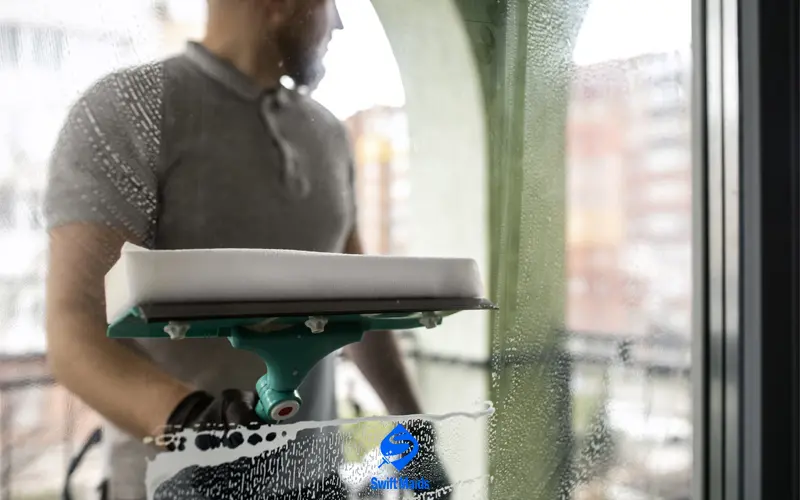Ugh, mold. The mere mention of the word can conjure up images of dark, fuzzy patches creeping across your windows. It’s enough to make any homeowner groan. But fear not! Mold on windows, while unsightly and potentially harmful, can be tackled with our comprehensive cleaning moldy windows guide.
This guide will equip you with the knowledge and tools to banish those pesky spores and restore your windows to their sparkling glory.
First Things First | Understanding Mold
Before we dive into scrubbing techniques, let’s take a moment to understand what we’re up against. Mold is a type of fungus that thrives in damp environments. Your windows, especially those in areas with poor ventilation or condensation problems, can become prime real estate for mold growth.
There are many different types of molds, but the good news is that most household mold varieties are not inherently dangerous. However, prolonged exposure to mold spores can irritate the respiratory system, especially for those with allergies or asthma. So, while a little bit of mold might not be cause for immediate panic, it’s definitely something you’ll want to address sooner rather than later.
Read Also: How to Remove Mold Off Wood Furniture
Identifying Moldy Windows | The Signs You Need to Know
How do you know if those dark spots on your windows are just harmless dirt or something more sinister? Here are some telltale signs of mold growth:
- Visible Discoloration: Mold typically appears as black, green, brown, or white patches or spots on the window frame or sash.
- Musty Odors: A damp, musty smell can sometimes accompany mold growth. If you notice a persistent unpleasant odor near your windows, take a closer look for signs of mold.
- Allergic Reactions: If you experience allergy or asthma symptoms like sneezing, coughing, or itchy eyes after spending time near moldy windows, it’s a strong indication that you need to take action.
Safety First | Protecting Yourself Before Cleaning Moldy Windows
Before you grab the nearest cleaning solution and start scrubbing, it’s crucial to protect yourself. Mold spores can be irritating to the respiratory system, so here are some safety precautions to take:
- Open some windows: Create good ventilation in the area you’ll be cleaning to prevent mold spores from circulating indoors.
- Don the gear: Wear gloves, a mask, and eye protection to minimize your exposure to mold spores.
- Clothing matters: Wear clothes you can easily wash after cleaning the mold.
DIY Mold Removal | Your Cleaning Arsenal
Now that you’re prepped and protected, let’s get down to business! Here are some effective methods for cleaning moldy windows:
The Vinegar Powerhouse
Vinegar is a natural disinfectant and a great first line of defense against mold. Mix equal parts white vinegar and water in a spray bottle. Spritz the moldy areas generously, let it sit for 15-20 minutes, then scrub with a stiff brush. Wipe the area clean with a damp cloth and allow it to dry completely.
The Baking Soda Bonanza
Another natural cleaning champion, baking soda is mildly abrasive and can help lift mold spores. Create a paste with baking soda and water and apply it to the moldy areas. Let it sit for 30 minutes, then scrub with a brush and rinse with clean water.
The Borax Brigade
Borax is a natural cleaning booster that can be particularly effective against mold.
Caution: Borax can irritate skin and eyes, so be sure to wear gloves and eye protection when using it. Mix 1 tablespoon of borax with 1 gallon of hot water. Dip a sponge or rag in the solution and scrub the moldy areas. Rinse thoroughly with clean water.
Important Note: Always test any cleaning solution on a small, inconspicuous area of the window frame or sash first to ensure it doesn’t cause any discoloration.
For Stubborn Mold | When to Call in the Cavalry
If the mold growth is extensive, deeply ingrained, or you’re uncomfortable tackling it yourself, don’t hesitate to call in professional help. Professional window cleaning companies (like Swift Maids! We offer window cleaning Calgary, Alberta, by the way!) have the experience and equipment to safely and effectively remove mold and ensure your windows are sparkling clean. They might also use stronger cleaning solutions or methods like pressure washing for heavily mold-infested areas, which shouldn’t be attempted by DIY warriors.
Preventing Mold Growth |Keeping Your Windows Mold-Free
Now that you’ve vanquished the mold, here are some home cleaning tips to prevent it from returning and taking up residence on your windows again:
Increase Ventilation
Proper ventilation is key to preventing moisture buildup. Open windows regularly, especially in areas prone to condensation, like bathrooms and kitchens.
Address Condensation Issues
If you notice excessive condensation on your windows, it might be a sign of poor insulation or ventilation. Consider addressing the underlying cause, such as installing a dehumidifier or improving insulation around windows.
Keep it Clean
Regularly clean your windows, both the glass and the frames. This removes dirt, dust, and other debris that can provide a breeding ground for mold spores.
Trim Back Overgrowth
If trees or shrubs are growing too close to your windows, they can block sunlight and promote moisture buildup. Trim back any overgrown vegetation to allow for better airflow around your windows.
Final Word
Cleaning moldy windows can be a nightmare, but with the right approach, you can banish those spores and restore your windows to their gleaming best. Remember, safety comes first, so don’t hesitate to suit up and protect yourself before tackling mold removal. For extensive mold growth or if you’re feeling overwhelmed, consider calling in professional help.
By following these tips and incorporating regular cleaning into your routine, you can keep your windows mold-free and ensure a bright, beautiful view for years to come. Now, go forth and conquer that mold! Your windows (and your lungs) will thank you for it.





